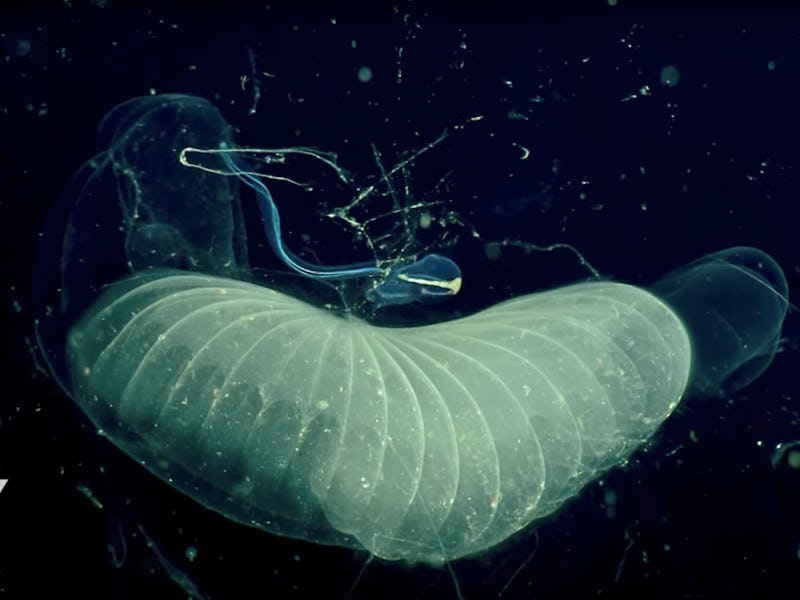These Sea Critters Trap and Remove Microplastics From Oceans
They're cleaning up our mess.

Meet Bathochordaeus, a squishy floaty thing that calls the open ocean home and just may have figured out how to do what humans have not: filter microplastic junk out of seawater and remove it permanently. That’s the conclusion of new research, published Wednesday in Science Advances, which tested the ability of these critters to trap microplastics in their natural environment.
Bathochordaeus belongs to a group of animals called the giant larvaceans. Its body looks like a transparent tadpole, around which it builds layers of mucous that gather and filter morsels of food for consumption. Although the animal itself is about the size of a pinkie finger, its “house” can span three feet in diameter.
This creature is uniquely adapted to collecting tiny things. The outer layer of the house keeps larger stuff out, while the inner layer concentrates the material and delivers it to the mouth. The larvacean’s tail creates a current, which pulls the water and its contents through the system. When the filters get clogged, the animal sheds the whole thing and sets to building new ones.
Larvaceans are common, and a single giant larvacean can filter seawater at a rate of up to 20 gallons per hour. The study authors estimate that the giant larvacean population of Monterey Bay, California, could filter all the water at their depth level in a matter of two weeks. Which means — at least potentially — that all humans have to do is stop allowing more plastic junk to enter the oceans, and let our invertebrate friends take care of the rest.
Of course, it’s not so simple. In fact, there’s a great deal we don’t know about what happens to plastic after we let it loose on the world and that’s part of what the researchers at Monterey Bay Aquarium Research Institute, led by Kakani Katija and Anela Choy, set out to investigate.
Colored microplastic beads accumulate in the larvacean's inner house and in its gut.
They completed the study by sending underwater robots down to release colored bits of plastic near giant lavaceans, and track how they moved through the system. The microbeads did indeed end up caught in the Bathochordaeus trap. Some were caught in the house, and dropped to ocean floor after it was shed. Others were ingested by the animals, and then expelled in their poop, which also sinks.
The study shows that giant larvaceans could be an important driver of movement of plastic junk from the mid-depths of the ocean to sediments on the seafloor. But they could also be the mechanism through which plastics enter and begin to accumulate in food chains. Lots of things eat larvaceans — both the animals themselves and the food-rich mucus filters they build around themselves. When they shed their houses, this becomes an important food source for creatures deeper down. If larvaceans are eating plastic, so too are all the things that eat them.
After 12 hours, the plastic had moved completely through the animal. Fecal pellets held colored beads of various sizes.
There’s a still a lot left unknown. We don’t know how much plastic the larvaceans are actually taking in, or even the concentrations of microplastics at the depths that they feed. It could be that most of the ocean’s plastic lives too close to the surface to mingle with Bathochordaeus all that often. We also don’t know the impacts of ingesting these plastics on larvaceans and the things that prey on them, and how much can enter food chains before they start wreaking havoc on biological systems.
What we do know is that the plastic garbage problem isn’t going away soon, and it’s an incredibly difficult mess to clean up. By one estimate there will be more plastic than fish by mass in the world’s oceans by 2050. And most of this is in the form of microplastics — 1/5 of an inch long or smaller. These are accumulating in great garbage patches that spread across the world’s oceans, and filtering them out without disrupting ecosystems is no easy task, even for a giant larvacean.
Abstract: Plastic waste is a pervasive feature of marine environments, yet little is empirically known about the biological and physical processes that transport plastics through marine ecosystems. To address this need, we conducted in situ feeding studies of microplastic particles (10 to 600 μm in diameter) with the giant larvacean *Bathochordaeus stygius. Larvaceans are abundant components of global zooplankton assemblages, regularly build mucus “houses” to filter particulate matter from the surrounding water, and later abandon these structures when clogged. By conducting in situ feeding experiments with remotely operated vehicles, we show that giant larvaceans are able to filter a range of microplastic particles from the water column, ingest, and then package microplastics into their fecal pellets. Microplastics also readily affix to their houses, which have been shown to sink quickly to the seafloor and deliver pulses of carbon to benthic ecosystems. Thus, giant larvaceans can contribute to the vertical flux of microplastics through the rapid sinking of fecal pellets and discarded houses. Larvaceans, and potentially other abundant pelagic filter feeders, may thus comprise a novel biological transport mechanism delivering microplastics from surface waters, through the water column, and to the seafloor. Our findings necessitate the development of tools and sampling methodologies to quantify concentrations and identify environmental microplastics throughout the water column.